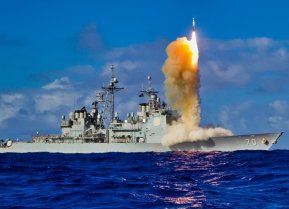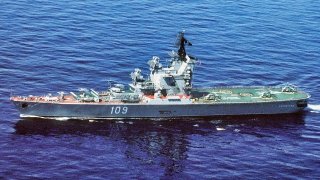Moskva-Class: Russia's Aircraft Carrier That Really Isn't An Aircraft Carrier
Russia's Cold War Moskva-class shouldn't be seen as an "aircraft carrier" in the traditional sense, as it wasn't designed to carry any fixed-wing aircraft.
The Moskva-class - Russia's Project 1123 Kondor Helicopter Cruisers: In the 1960s, the Soviet Navy was sizeable in number, yet lacked many of the capabilities of western navies – notably the United States Navy. The Soviets had never constructed an aircraft carrier, but with the Project 1123 Kondor – also known as the Moskva -class – Moscow looked to change that fact. This would be the first class of warships designed to carry aircraft.
Meet the Moskva-Class
During the 1950s, the Soviets had conducted a study on light aircraft carriers – after already noting that half of the Soviet's large warships had been sunk in World War II by enemy aircraft. However, political pressure put the end to the development of a true carrier. Instead a smaller vessel was conceived.
As a result, the Moskva-class shouldn't be seen as an "aircraft carrier" in the traditional sense, as it wasn't designed to carry any fixed-wing aircraft. Instead its air wing was composed entirely of helicopters. The vessels were also designed primarily for anti-submarine warfare (ASW) role – to counter the NATO Polaris submarines – and to act as flagship for other ASW warships. As such the weapons and sensor suite was fully optimized against a nuclear submarine threat.
Moreover, instead of serving as part of the nation's force projection, the Soviet doctrine called for the warships to serve in a strategic role that included defending the Soviet ballistic missile submarine bastions against incursions by Western attack submarines. The designs were comparable to the French Jeanne d'Arc and the Italian Vittorio Venteo – with multipurpose naval armament on the forward part of the ship, and the aft used to launch and recover the rotary-wing aircraft.
The Moskva-class was armed with a twin SUW-N-1 launcher that was capable of delivering a FRAS-1 projectile carrying a 450-millimeter (18 in) torpedo, or alternatively a five kiloton nuclear warhead; as well as a pair of RBU-6000 ASW mortars; and a set of torpedo tubes. For self-defense, the helicopter carrier was equipped with two twin SA-N-3 surface-to-air missile (SAM) launchers with reloads for a total of 48 surface-to-air missiles, along with two twin 57 mm (2.2 in) /80 guns. Initially, Soviet designers had sought to operate around ten helicopters from an 8,000-ton warship, but the design was enlarged to nearly 12,000 tons. The larger vessel proved capable of operating up to 14 rotary wing aircraft with self defense armament.
The size of the ships proved to be a problem when it came to propulsion, and originally gas turbines were considered, but designers noted concerns as the engines were untried in such a large vessel. Instead, it was determined that a high pressure steam plant similar to that used by the Kynda-class cruisers could be employed.
However, as with other Soviet designs, it was far from perfect. The machinery on the Moskva had notable issues and the warship had to undergo a refit in 1973 following a fire in her engine room. She was taken out of service for nearly a year.
Operational performance also proved to be disappointing, and the class was able to achieve practical maximum speed of 30 knots (56 km/h; 35 mph) and 24-knot (44 km/h; 28 mph) maximum sustainable speed.
Moskva, which was named for the City of Moscow, and her sister ships – Leningrad and Kiev – were laid down at the Soviet Shipyard No. 444, Mykolaiv in Ukraine between December 1962 and December 1967. However, only the first two ships of the class were completed, with Moskva being commissioned on December 25, 1967 and Leningrad on June 2, 1969. Both vessels served as part of the Soviet Navy's Black Sea Fleet. Due to the problems that the lead ship faced, the third ship in the class was canceled.
About the Author
Peter Suciu is a Michigan-based writer who has contributed to more than four dozen magazines, newspapers and websites. He regularly writes about military hardware, and is the author of several books on military headgear including A Gallery of Military Headdress, which is available on Amazon.com. Peter is also a Contributing Writer for Forbes.


